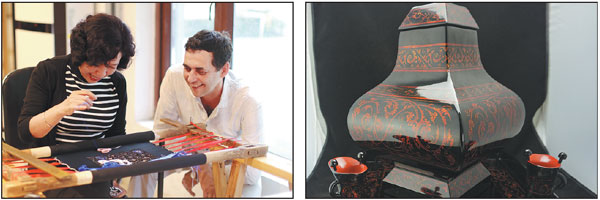Traditional craftsmanship of cultural heritage continues to sew success
As far back as 2,000 years ago, Sichuan brocade, embroidery and lacquerware were sought out by people far and wide for their excellent quality and exquisite appearance. Today, the traditional skills required to make these treasures are still being passed down from generation to generation in Chengdu.
During the seventh China Chengdu International Festival of Intangible Cultural Heritage, a large, ornately decorated black lacquer wine container, streaked with red patterning drew much attention.
The work, characterized with floral and cloud patterns, was done by Song Xiping, a national-level intangible cultural heritage inheritor of Chengdu lacquer art. It took Song seven years to finish the artwork.
|
From left: Eric Benque, a French artist studies the technique of Shu embroidery from an intangible cultural heritage inheritor. An ornately decorated black lacquer wine container, streaked with red patterning exhibited at a museum in Chengdu. Photos Provided to China Daily |
"I'm 68 years old this year. I may not have as much energy in the future, so I want to make as many as I can. I hope the glory of Chengdu's lacquer art can be fully illuminated through my work," Song said.
Chengdu is one of the birthplaces of Chinese lacquer art, which rose to prominence from the Shang Dynasty (c. 16th century-11th century BC) to the Eastern Zhou Dynasty (770-256 BC), its technology far ahead of the rest of China for quite a long time.
In the 1970s, the unearthed relics of the Mawangdui tombs of the Han Dynasty (206 BC-AD 220) in Changsha caused a sensation across the world. Some of the exquisite lacquerware discovered in the tombs came from Chengdu.

Song began working at Chengdu lacquer factory shortly after the Chengdu-made lacquerware was unearthed in the Mawangdui tombs.
"I always remember how much I was shocked when I saw the lacquerware unearthed from the tombs," Song said.
When creating some of her classic works she has been inspired by the lacquerware unearthed from the tombs.
The production of lacquerware includes more than 100 individual processes.
"I started my career at the age of 21, and I've been practicing these skills for 47 years. In the future, I want to teach more of the younger generation," Song said.
Shu embroidery, another national intangible cultural heritage, is being passed down by a group of intangible cultural heritage inheritors in Chengdu.
Shu embroidery is one of the most famous styles of embroidery in China, along with Su embroidery, Xiang embroidery and Yue embroidery.
Meng Dezhi, 58, is a national-level intangible cultural heritage inheritor of Shu embroidery.
Born to a family of embroiderers, she was one of the most talented employees at the Chengdu Shu embroidery factory. However, faced with the market impacts brought by cheap industrial products made by modern machines, the factory closed down in 2005.
In order to make a living, Meng rented a small space of 10 square meters to teach Shu embroidery skills.

When the district government in Chengdu learned about it, it provided 70,000 yuan ($9,899) venture capital for a new workshop. Meng used the workshop to recruit laid-off workers to study Shu embroidery.
Today, Meng has established her own company and got opportunities to cooperate with several famous international fashion houses.
She has also established teaching bases to popularize the culture of Shu embroidery in universities and residential communities.
"In the early days, I set up the company just for survival, but now I really feel that I have the responsibility to pass on Shu embroidery skills to young people, to let it run from generation to generation," she said.
In Chengdu, there is a large number of intangible cultural heritage inheritors like Song and Meng, and there are more than 500 intangible cultural heritage projects being cultivated in the city, including 22 national-level intangible cultural heritage projects.
(China Daily 10/25/2019 page19)















